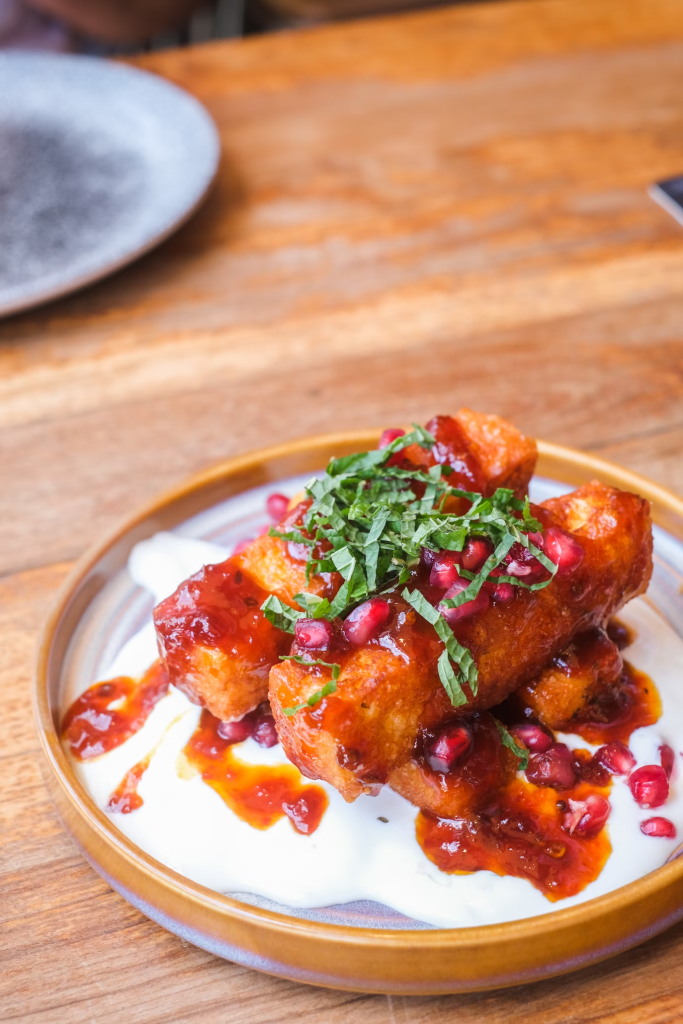Australia, often hailed as a cultural melting pot, mirrors its diverse populace through its culinary landscape. With influences ranging from Indigenous traditions to European, Asian, and Middle Eastern cultures, Australian cuisine is a vibrant tapestry of flavours and techniques. In this article, we will delve into some of the most popular cuisines that have left an indelible mark on the Australian culinary scene.

1. Modern Australian Cuisine
Modern Australian cuisine is a fusion of various culinary traditions, characterized by the use of fresh, local produce and a focus on innovative techniques. It emerged in the late 20th century, blending influences from European and Asian cuisines. The emphasis on high-quality ingredients and creative presentation has earned it a special place in the hearts of Australians.
Dishes like Barramundi with Lemon Myrtle, Kangaroo Carpaccio, and Pavlova are quintessential examples of this genre. Additionally, the farm-to-table movement, which prioritizes locally sourced, seasonal ingredients, has further propelled Modern Australian cuisine to the forefront of the culinary world.
2. Italian Cuisine
Italian cuisine holds enduring popularity in Australia. Waves of Italian immigrants brought with them a rich culinary heritage that has become an integral part of Australian gastronomy. Pasta, pizza, risotto, and hearty dishes like Osso Buco have found a permanent place on Australian dinner tables.
Melbourne, often hailed as the culinary capital of Australia, is renowned for its Italian eateries. Lygon Street, in particular, is celebrated for its abundance of authentic Italian restaurants, offering everything from traditional Neapolitan-style pizzas to exquisite handmade pasta.
3. Asian Influences
Asian cuisines have significantly shaped the Australian palate. The influx of immigrants from countries like China, Vietnam, Thailand, and Japan has led to a proliferation of Asian eateries across the nation. Chinese cuisine, with its diverse regional styles, is a perennial favourite. From dim sum to Peking duck, Australians relish the diverse offerings of Chinese kitchens.
Japanese cuisine, known for its precision and simplicity, has also gained a devoted following. Sushi, sashimi, and ramen have become staple choices for many Australians seeking a light and healthy dining option.
4. Mediterranean Delights
The Mediterranean diet, renowned for its health benefits and vibrant flavours, has captivated the Australian palate. Greek cuisine, with its emphasis on olive oil, vegetables, and grilled meats, has become a beloved choice for both casual and celebratory dining. Dishes like moussaka, souvlaki, and baklava have entrenched themselves in the Australian culinary lexicon.
Similarly, Spanish tapas and Italian antipasti have found favour among those seeking a convivial, communal dining experience. The bold flavours of olives, cured meats, and cheeses have become a cherished part of Australian dining culture.
5. Middle Eastern and North African Influences
The aromatic spices and bold flavours of Middle Eastern and North African cuisines have made a significant impact on the Australian culinary landscape. Dishes like falafel, hummus, kebabs, and tagines have become popular choices for diners seeking a taste of the exotic.
Lebanese cuisine, in particular, has a strong presence in Australian cities. From mezze platters to succulent grilled meats, Lebanese restaurants offer a rich tapestry of flavours that have been embraced by Australians.
6. Indigenous Cuisine
Acknowledging and celebrating the Indigenous culinary heritage of Australia is essential in understanding the country’s gastronomic evolution. Bush tucker, which encompasses a range of native ingredients like kangaroo, emu, quandong, and wattleseed, forms the basis of Indigenous cuisine.
Modern chefs are increasingly incorporating these ingredients into their dishes, creating a fusion of traditional and contemporary flavours.
Furthermore, the revival of Indigenous cooking techniques, such as the use of smoke and native spices, has garnered attention and admiration from the culinary world.
What Are 3 Popular Foods In Australia?
Three popular foods in Australia are:
1. Meat Pies:
Meat pies are an iconic dish in Australian cuisine, deeply ingrained in the culinary culture of the country. They are considered a comfort food and are widely loved by Australians of all ages. Here’s a closer look at this beloved dish:
Origins and History:
The origins of the meat pie can be traced back to early British settlers who brought with them a tradition of savoury pies. These pies were practical and portable, making them suitable for early Australian life, especially among miners and labourers.
Ingredients and Preparation:
The classic Australian meat pie consists of a flaky pastry crust filled with a mixture of diced or minced meat, typically beef, along with gravy, onions, and various seasonings. The choice of meat can vary, and some variations include lamb or a mixture of meats.
The filling is often enhanced with flavours like Worcestershire sauce, tomato paste, and herbs like rosemary and thyme. Vegetables like carrots and peas may also be included for added texture and flavour.
Serving and Accompaniments:
Meat pies are often enjoyed with a dollop of tomato sauce (ketchup), though preferences may vary. They can be found in a variety of settings, from corner bakeries and take-out shops to sporting events and picnics.
In addition to tomato sauce, they can also be served with mashed potatoes, mushy peas, or a side salad, depending on personal preference.
Regional Variations:
Different regions in Australia may have their unique twists on the classic meat pie. For instance, in South Australia, the “pie floater” is a popular variation where a meat pie is served in a bowl of pea soup.
Cultural Significance:
Meat pies hold a special place in Australian culture. They are often associated with sports events, and they’re a common choice for fans at rugby, football, and cricket matches. The “pie and sauce” is a classic and cherished snack for many Australians.
Beyond Tradition:
While the classic meat pie remains immensely popular, contemporary chefs and bakers have also started to experiment with gourmet variations, incorporating different meats, sauces, and pastry types to create unique and innovative takes on this beloved dish.
The meat pie is a beloved and iconic dish in Australia, deeply woven into the cultural fabric of the country. Its humble yet hearty nature, combined with its wide availability, has solidified its status as a culinary treasure cherished by Australians across the nation.
2. Vegemite:
Vegemite is a quintessential Australian condiment, known for its distinctive savoury flavor and deep cultural significance. Here, we explore the history, ingredients, and cultural impact of this beloved spread.
Origins and History:
Vegemite was first introduced in the 1920s by Fred Walker & Co. (later known as the Kraft Food Company) in Melbourne, Australia. It was created by Dr Cyril Percy Callister, a chemist and food technologist, as a way to utilize leftover brewer’s yeast extract, a byproduct of beer production. The spread was initially named “Parwill” but was later rebranded as “Vegemite” in 1923.
Ingredients and Production:
Vegemite is made from a blend of yeast extract, and various vegetable and spice additives, and is enriched with B vitamins, particularly B1, B2, B3, and folate. The primary ingredient, yeast extract, gives Vegemite its distinctive umami-rich and salty flavour. It is known for being a vegetarian and vegan-friendly food source.
The production process involves the concentration of yeast extract, followed by the addition of specific flavourings and seasonings. The final product is a thick, dark brown paste with a concentrated, salty taste.
Consumption and Usage:
Vegemite is typically spread thinly on bread, crackers, or toast, usually with butter or margarine. It can also be used in various recipes, such as soups, stews, and marinades, to impart a unique savoury flavour. Some creative culinary enthusiasts have even incorporated Vegemite into dishes like pasta sauces and meat marinades.
Cultural Significance:
Vegemite holds a special place in Australian culture. It is considered a national icon, often evoking a strong sense of nostalgia and patriotism. The “Vegemite sandwich” is a classic and simple meal for many Australians, especially children.
Furthermore, Vegemite has been immortalized in popular culture through songs, advertisements, and even as a symbol of Australian identity. The jingle “We’re Happy Little Vegemites” from a famous advertising campaign in the 1950s remains etched in the memories of generations.
Nutritional Value:
Vegemite is a nutrient-dense food source, containing essential B vitamins, which are crucial for energy metabolism and overall health. It is also relatively low in fat and calories, making it a popular choice for a quick, nutritious snack.
International Reception:
While Vegemite is an Australian icon, its strong, savoury flavour can be an acquired taste for those unfamiliar with it. Some international audiences may find it intense compared to sweeter spreads like jam or peanut butter. Nevertheless, it has gained a following among global consumers interested in exploring diverse culinary experiences.
In summary, Vegemite is more than just a spread—it’s a cultural touchstone, a symbol of Australian identity, and a nutritious addition to many Australians’ diets. Its distinctive taste and rich history continue to make it a cherished staple in households across the country.
3. Barbecue (Barbie):
Barbecue, affectionately known as “barbie” in Australia, is a cherished culinary tradition that holds a special place in the hearts of Australians. Here, we delve into the origins, cultural significance, and diverse manifestations of this popular outdoor cooking style.
Origins and History:
The practice of outdoor grilling and barbecuing can be traced back to Indigenous Australian communities who used traditional methods to cook meats over open flames. With the arrival of European settlers, this cooking technique was embraced and evolved, leading to the development of modern barbecuing in Australia.
Culinary Technique:
Australians have perfected the art of barbecuing, which involves grilling various meats and seafood outdoors on a grill or barbecue pit. The method typically uses charcoal, wood, or gas as the heat source. This technique imparts a distinctive smoky flavour to the food, creating a unique and delectable taste.
Popular Barbecue Items:
The choice of meats for the barbie is diverse, ranging from sausages, steaks, and lamb chops to prawns, fish, and even kangaroo. Marinades and seasonings are used to enhance flavours, with popular options including garlic, rosemary, lemon, and various spice blends.
Accompaniments:
Barbecue gatherings are often accompanied by an array of side dishes. These may include salads, coleslaw, baked potatoes, corn on the cob, and a variety of sauces and condiments to complement the grilled meats. A Classic Australian barbecue often features a mix of flavours, textures, and tastes to cater to various preferences.
Cultural Significance:
Barbecues are more than just a method of cooking; they represent a cherished social and cultural tradition in Australia. They provide an opportunity for friends and families to come together in a relaxed and informal setting, fostering a sense of community and camaraderie.
Events and Celebrations:
Barbecues are an integral part of Australian celebrations and gatherings. From casual weekend cookouts in suburban backyards to large-scale events like the “Aussie BBQ” held on public holidays, barbecuing is a versatile culinary practice that adapts to various occasions.
Regional Influences:
Different regions of Australia may have their unique barbecue styles and preferences. For instance, South Australia is known for its distinctive “braai” (barbecue) culture, influenced by its strong German heritage.
Innovation and Gourmet Barbecuing:
While traditional barbecuing remains immensely popular, contemporary chefs and enthusiasts have embraced innovation, experimenting with different marinades, woods, and cooking techniques to create gourmet barbecue experiences. This includes slow-cooked, smoked meats and fusion dishes that showcase the versatility of the barbecue.
The Australian barbecue, or “barbie,” is more than just a cooking method; it’s a cultural phenomenon that brings people together, celebrates the great outdoors, and embodies the laid-back spirit of Australia. It’s a culinary tradition that continues to evolve while remaining a cherished and unifying aspect of Australian culture.
Conclusion
Australia’s culinary landscape is a testament to its multicultural society. The convergence of diverse culinary traditions has birthed a unique and vibrant food culture. From the innovative techniques of Modern Australian cuisine to the comforting familiarity of Italian pasta, the richness of Asian flavours, and the boldness of Middle Eastern spices, Australia’s most popular cuisines offer a delightful journey for the palate.
Embracing this diversity not only enriches the dining experience but also reflects the harmonious coexistence of cultures in this great southern land.
